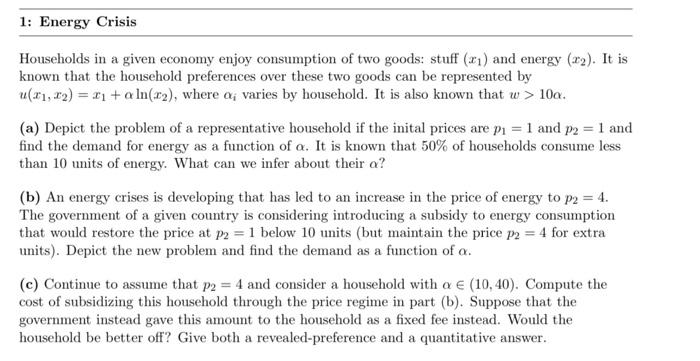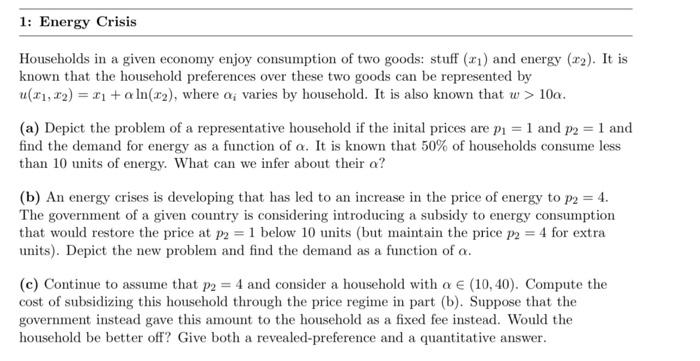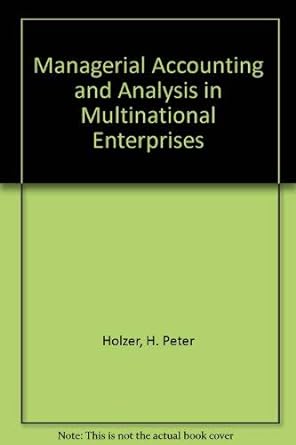Answered step by step
Verified Expert Solution
Question
1 Approved Answer
Households in a given economy enjoy consumption of two goods: stuff (x1) and energy (x2). It is known that the household preferences over these two
Households in a given economy enjoy consumption of two goods: stuff (x1) and energy (x2). It is known that the household preferences over these two goods can be represented by
u(x1, x2) = x1 + ln(x2), where i varies by household. It is also known that w > 10.
(a) Depict the problem of a representative household if the inital prices are p1 = 1 and p2 = 1 and find the demand for energy as a function of . It is known that 50% of households consume less than 10 units of energy. What can we infer about their ?
(b) An energy crises is developing that has led to an increase in the price of energy to p2 = 4. The government of a given country is considering introducing a subsidy to energy consumption that would restore the price at p2 = 1 below 10 units (but maintain the price p2 = 4 for extra units). Depict the new problem and find the demand as a function of .
(c) Continue to assume that p2 = 4 and consider a household with (10, 40). Compute the cost of subsidizing this household through the price regime in part (b). Suppose that the government instead gave this amount to the household as a fixed fee instead. Would the household be better off? Give both a revealed-preference and a quantitative answer.

That is all i have.. 
Households in a given economy enjoy consumption of two goods: stuff (x1) and energy (x2). It is known that the household preferences over these two goods can be represented by u(x1,x2)=x1+ln(x2), where i varies by household. It is also known that w>10. (a) Depict the problem of a representative household if the inital prices are p1=1 and p2=1 and find the demand for energy as a function of . It is known that 50% of households consume less than 10 units of energy. What can we infer about their ? (b) An energy crises is developing that has led to an increase in the price of energy to p2=4. The government of a given country is considering introducing a subsidy to energy consumption that would restore the price at p2=1 below 10 units (but maintain the price p2=4 for extra units). Depict the new problem and find the demand as a function of . (c) Continue to assume that p2=4 and consider a household with (10,40). Compute the cost of subsidizing this household through the price regime in part (b). Suppose that the government instead gave this amount to the household as a fixed fee instead. Would the household be better off? Give both a revealed-preference and a quantitative answer. Households in a given economy enjoy consumption of two goods: stuff (x1) and energy (x2). It is known that the household preferences over these two goods can be represented by u(x1,x2)=x1+ln(x2), where i varies by household. It is also known that w>10. (a) Depict the problem of a representative household if the inital prices are p1=1 and p2=1 and find the demand for energy as a function of . It is known that 50% of households consume less than 10 units of energy. What can we infer about their ? (b) An energy crises is developing that has led to an increase in the price of energy to p2=4. The government of a given country is considering introducing a subsidy to energy consumption that would restore the price at p2=1 below 10 units (but maintain the price p2=4 for extra units). Depict the new problem and find the demand as a function of . (c) Continue to assume that p2=4 and consider a household with (10,40). Compute the cost of subsidizing this household through the price regime in part (b). Suppose that the government instead gave this amount to the household as a fixed fee instead. Would the household be better off? Give both a revealed-preference and a quantitative answer. Households in a given economy enjoy consumption of two goods: stuff (x1) and energy (x2). It is known that the household preferences over these two goods can be represented by u(x1,x2)=x1+ln(x2), where i varies by household. It is also known that w>10. (a) Depict the problem of a representative household if the inital prices are p1=1 and p2=1 and find the demand for energy as a function of . It is known that 50% of households consume less than 10 units of energy. What can we infer about their ? (b) An energy crises is developing that has led to an increase in the price of energy to p2=4. The government of a given country is considering introducing a subsidy to energy consumption that would restore the price at p2=1 below 10 units (but maintain the price p2=4 for extra units). Depict the new problem and find the demand as a function of . (c) Continue to assume that p2=4 and consider a household with (10,40). Compute the cost of subsidizing this household through the price regime in part (b). Suppose that the government instead gave this amount to the household as a fixed fee instead. Would the household be better off? Give both a revealed-preference and a quantitative answer. Households in a given economy enjoy consumption of two goods: stuff (x1) and energy (x2). It is known that the household preferences over these two goods can be represented by u(x1,x2)=x1+ln(x2), where i varies by household. It is also known that w>10. (a) Depict the problem of a representative household if the inital prices are p1=1 and p2=1 and find the demand for energy as a function of . It is known that 50% of households consume less than 10 units of energy. What can we infer about their ? (b) An energy crises is developing that has led to an increase in the price of energy to p2=4. The government of a given country is considering introducing a subsidy to energy consumption that would restore the price at p2=1 below 10 units (but maintain the price p2=4 for extra units). Depict the new problem and find the demand as a function of . (c) Continue to assume that p2=4 and consider a household with (10,40). Compute the cost of subsidizing this household through the price regime in part (b). Suppose that the government instead gave this amount to the household as a fixed fee instead. Would the household be better off? Give both a revealed-preference and a quantitative 
Step by Step Solution
There are 3 Steps involved in it
Step: 1

Get Instant Access to Expert-Tailored Solutions
See step-by-step solutions with expert insights and AI powered tools for academic success
Step: 2

Step: 3

Ace Your Homework with AI
Get the answers you need in no time with our AI-driven, step-by-step assistance
Get Started


